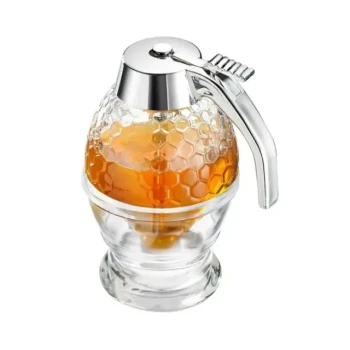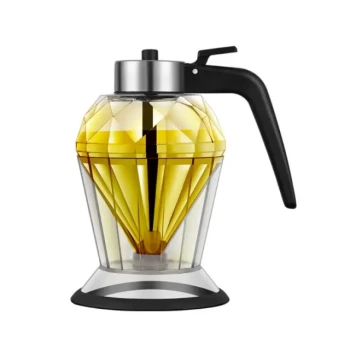At its core, a honey press is a simple and effective machine that extracts honey by crushing raw honeycomb. Unlike a centrifugal extractor that spins honey out, a press uses mechanical force to squeeze the honey from the wax cells, much like pressing grapes for wine. The raw honey flows through a filter and into a collection vessel, leaving behind a compressed cake of beeswax.
A honey press is a valuable tool for small-scale beekeepers and for maximizing yield by processing wax cappings. It excels at producing high-quality, raw honey but does so by destroying the honeycomb, which represents a significant trade-off compared to non-destructive extraction methods.

How a Honey Press Works: The Crushing Principle
A honey press operates on the straightforward principle of applying direct pressure. The process is manual, methodical, and results in a clean separation of liquid honey from solid wax.
Step 1: Loading the Comb
The press is loaded with raw material. This can be full frames of honeycomb, pieces of irregular burr comb built in odd places in the hive, or, most commonly, the wax cappings that are sliced off frames before they go into a centrifugal extractor.
Step 2: Applying Pressure
The user turns a handle or screw, which lowers a heavy pressure plate onto the honeycomb. As the user rotates the mechanism, immense force is applied, crushing the wax cells and forcing the honey to flow out. This continues until the flow of honey slows to a drip.
Step 3: Separating Honey and Wax
The press is designed with a perforated basket or a screened outlet. As the honey is squeezed out, it passes through this filter and is collected in a container placed below. The compressed beeswax remains behind in the press, ready to be removed and rendered for other uses.
Honey Press vs. Centrifugal Extractor: A Key Distinction
Understanding the difference between a press and an extractor is critical, as they serve different purposes and have vastly different impacts on your beekeeping operation.
The Press: Destructive Extraction
A honey press destroys the comb. This is its defining characteristic. By crushing the comb, you extract the maximum amount of honey, but the intricate wax structure the bees worked so hard to build is lost.
The Extractor: Non-Destructive Extraction
A centrifugal extractor uses centrifugal force to sling honey out of the cells. The frames are spun at high speed, and the honey flies out to the wall of the extractor, leaving the delicate wax comb intact. This allows the beekeeper to return the empty "wet" frames to the hive, giving the bees a massive head start on the next honey flow.
Understanding the Trade-offs
Choosing a honey press involves weighing its distinct advantages against its significant drawbacks.
Advantage: Maximizing Honey Yield
A press excels at extracting honey from sources that are difficult to process otherwise. It reclaims every last drop from wax cappings and irregular burr comb, significantly increasing your total harvest.
Advantage: Preserving Honey's Natural Character
Many purists believe pressing honey is a gentler method. Because it incorporates less air than high-speed spinning, it can better preserve the honey's delicate aromas and natural characteristics.
Disadvantage: It is Labor-Intensive
Pressing is a manual and often slow process. It can be physically demanding and time-consuming compared to using a powered centrifugal extractor, especially for larger harvests.
Disadvantage: The Comb is Destroyed
This is the most significant trade-off. Bees expend a tremendous amount of energy and consume large amounts of nectar to produce wax and draw out comb. Destroying it means they must start over from scratch, potentially reducing the next honey crop.
When to Choose a Honey Press
Your beekeeping goals will determine if a honey press is the right tool for you.
- If your primary focus is processing cappings and burr comb: A press is the perfect tool to reclaim valuable honey that would otherwise be difficult to access.
- If you are a small-scale or foundationless beekeeper (e.g., Top Bar or Warre hives): A press offers a simple, relatively low-cost extraction method well-suited for harvests where comb preservation is not the priority.
- If your primary focus is maximizing comb reuse for a large operation: A centrifugal extractor is the superior choice, as returning drawn comb to the bees is far more efficient.
Ultimately, a honey press is a specialized instrument that shines in the right context, empowering you to make the most of every part of your harvest.
Summary Table:
| Feature | Honey Press | Centrifugal Extractor |
|---|---|---|
| Method | Crushing with mechanical pressure | Spinning with centrifugal force |
| Comb Preservation | Destroys the comb | Leaves comb intact for reuse |
| Best For | Wax cappings, burr comb, small-scale harvests | Large-scale operations, frame-based hives |
| Key Advantage | Maximizes honey yield from all comb sources | Promotes hive efficiency by saving bees' work |
Maximize Your Honey Harvest with the Right Equipment
Choosing the right extraction method is crucial for your apiary's productivity. Whether you're a commercial beekeeper focused on efficiency or a distributor supplying the industry, HONESTBEE has the beekeeping supplies and equipment you need.
We supply durable, high-performance honey presses and centrifugal extractors tailored for commercial apiaries and distributors. Let our experts help you select the perfect tool to optimize your yield and operations.
Contact HONESTBEE today to discuss your equipment needs and wholesale pricing!
Visual Guide

Related Products
- Electric Honey Press Machine for Squeezing Honey Comb Press Equipment
- Easy Use Manual Stainless Steel Honey Press for Honey Comb
- 10L Stainless Steel Electric Honey Press Machine
- Stainless Steel Manual Honey Press with Guard for Pressing Honey and Wax
- Stainless Steel Honey Press Wax Press with Tank
People Also Ask
- How was the honey press cleaned after use? Quick vs. Deep Cleaning Methods Explained
- What are the reasons for choosing a honey press over a dedicated honey extractor? Maximize Disease Control and Natural Beekeeping
- How should a honey press be cleaned? A Step-by-Step Guide for Beekeepers
- How can a honey press be used beyond honey extraction? Unlock Its Full Potential for Your Farm
- How does using a honey press affect honeycomb reuse? It Destroys Comb but Captures Unique Honey & Wax



















